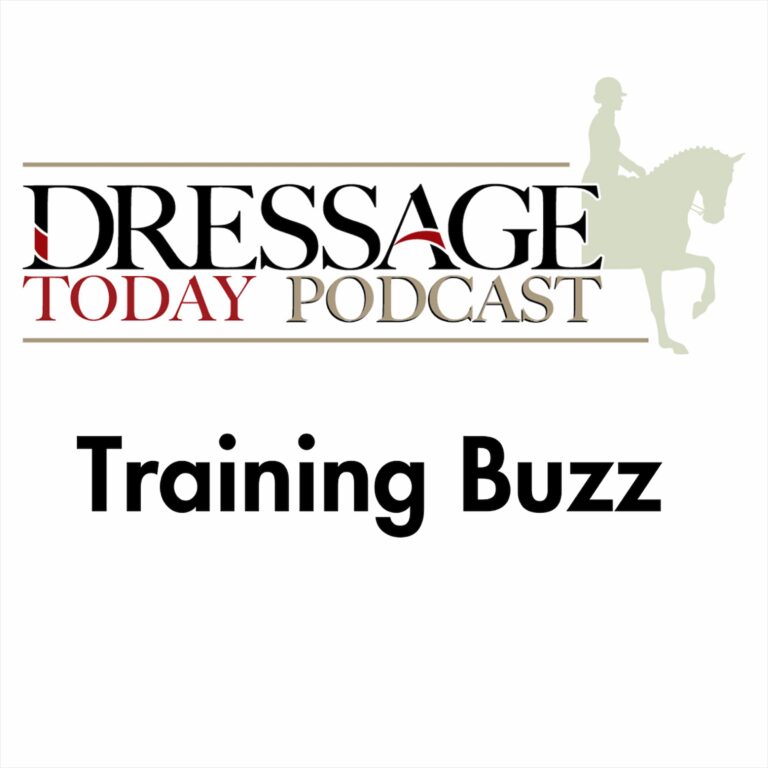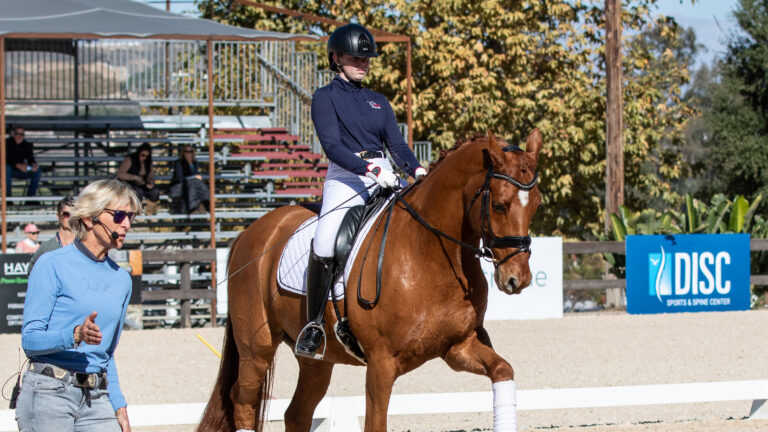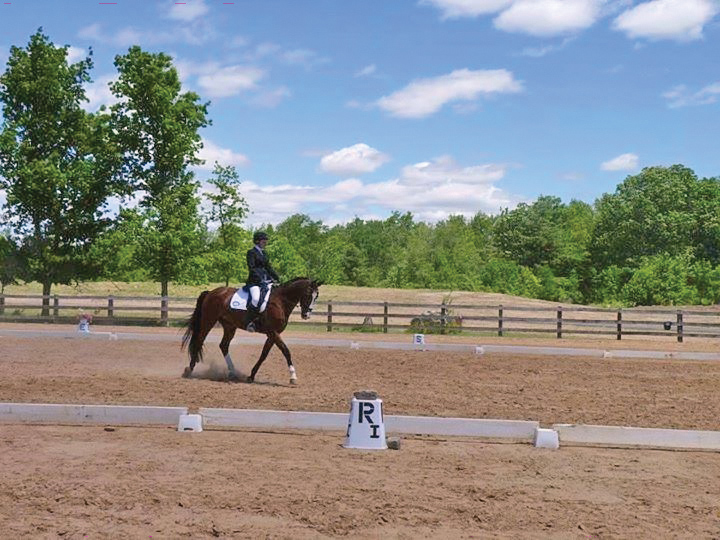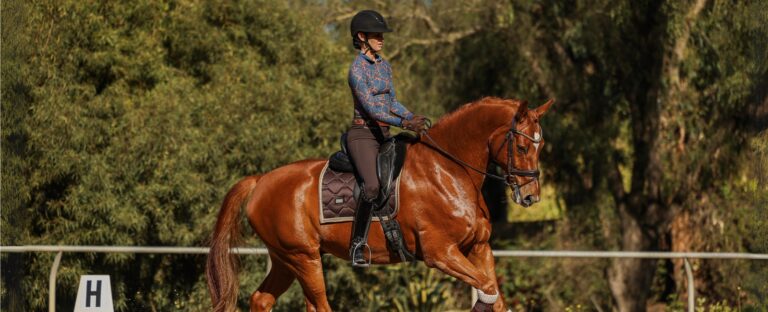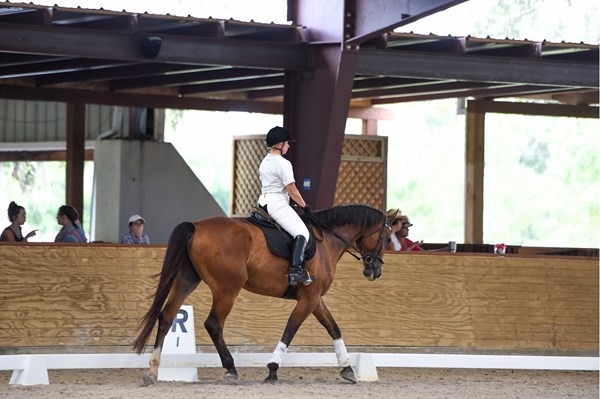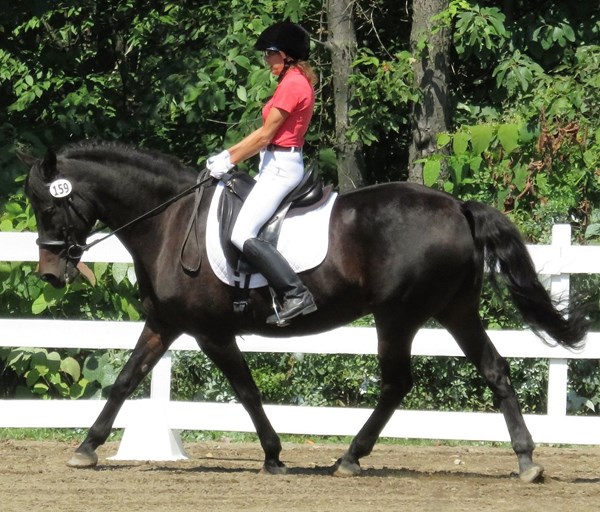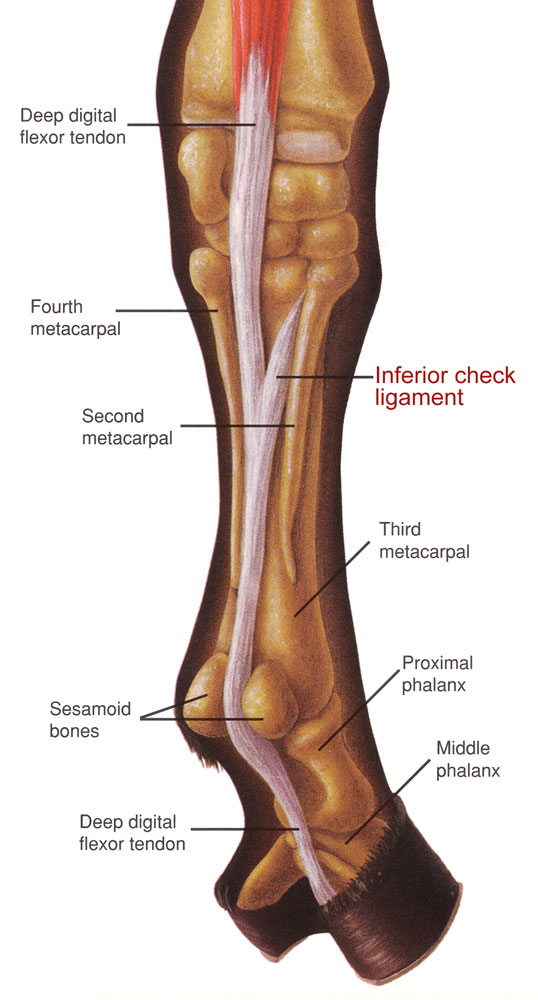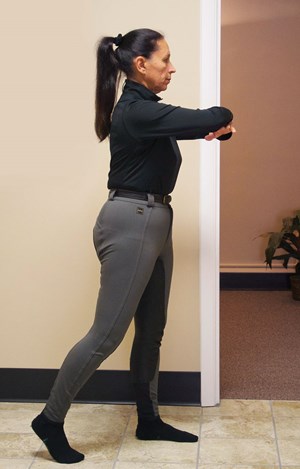
This picture shows Susanne Way riding her 11-year-old Morgan gelding, Joey, in a Training Level test at a schooling show. Joey is a typical Morgan, as he’s not too big but still fits a grown-up rider well. In the picture he looks very willing to perform and do anything his rider asks. He appears full of trust and eager but calm. Susanne said she and Joey do a lot of trail riding and clinics. Trail rides in particular can strengthen the bond between horse and rider, and this mutual trust can be seen in the picture. Here, Joey shows a nice frame for Training Level. He appears supple through his body as he looks for contact with a closed, foaming mouth.
Studying Susanne’s position, I notice a correct straight line from her hand to the horse’s mouth. Her pelvis is upright, but her shoulders are slightly rounded and her head is a bit forward. To account for lack of stability in her core and seat, she is using her upper legs to grip, which causes her lower leg to slide too far back. This often happens when a rider wants to sit deep and push the horse more forward from the leg.
The position for a correct forward-driving leg is described as “at the girth,” meaning that the front of the rider’s boot of her inside leg should be at the back line of the girth. The outside leg can be one hand farther behind. In this picture, Susanne’s leg is even farther behind than the correct outside leg position. This is a very common mistake and it happens when the rider has slightly too much tension in the back of her knee, as using the leg then results in bending the knee.
The correction of this habit starts in her upper-body balance. It is helpful to ride the trot in a jumping position as you think of balancing your seat all the time. This will correct your leg position, as it requires your balance to be based over your knees and stirrups. Out of the forward seat the rider can slowly make contact with the pelvis and bring the upper body back upright to the dressage seat. The focus in this task should be to keep your leg position steady while moving your upper body. This exercise helps establish a better leg position and teaches you to feel how much easier it is to keep the leg long when you stretch in your upper body at the same time.
For Susanne it will be important to learn to stretch up in her thoracic spine (chest) while bringing her shoulders down. It could be helpful for her to combine this with a simple breathing exercise.
Try this: When breathing in, let your shoulders lift up toward your ears, as if the air floats them up. When breathing out, you should lengthen your neck and bring your shoulders as far down as possible in opposition to your head stretching up. Imagining that your shoulder blades slide down and around the back of your chest on your ribs can help you find stability that can give your hands better connection and independence. It is like the shoulder blades help to push your chest forward and up so that when your hand is giving forward to the contact, your shoulders can help you straighten instead of rounding. With more straightness from above, it will be easier to stabilize your lower leg.
The following exercise should explain how the leg aid works. Try this: If you place your hand on your thigh and, without moving it, push in different directions, you can clearly feel in your leg where your hand is pushing and how it activates very different muscles in your whole body. More important for the horse than a correct leg position is the direction the contact of the leg gives to the horse. How else could a rider with long legs and a rider with short legs communicate with the same horse?
When placing the leg at the horse’s side, one can push to all different directions just like the hand described above. This, too, activates many different automatic muscles within the rider’s body. The message a forward-driving leg should give to the horse is “forward.” When the knee is bent, the lower leg pushes backward and up, giving the horse the message to push with the hind leg back out and lift the croup. This is opposite to the first direction, which was step forward under the weight and lower the croup.
When she keeps her lower leg at the horse’s side and imagines pushing slightly forward and in an uphill direction, Susanne will feel that her seat deepens and Joey may understand the message more easily. When she looks at the picture again, she should see that the angle of her lower leg matches the horse’s opposite hind leg pushing out and the croup is still a little high. For Training Level the activity from behind is enough, but I do point this out so she understands what is needed to lighten the horse’s forehand. I wish Susanne and Joey all the best.
Susanne von Dietze is a leader in equestrian biomechanics. A physiotherapist, licensed instructor and judge for dressage and show jumping, she gives lectures and seminars throughout the world. She is a native of Germany and now lives in Israel, where she competes at the international level. She is the author of two books on the biomechanics of riding: Balance in Movement and Horse and Rider, Back to Back. Find her books at www.EquineNetworkStore.com.
Send Your Photo!
You can submit your high-resolution dressage photo for critique (300 dpi and 4 by 6 inches in size). Or you can send your photo with a link to a short video. Email to [email protected]. Turnout in dressage show or clinic-appropriate attire is encouraged. Don’t forget your helmet!


